Český Krumlov
Český Krumlov (Czech pronunciation: [ˈtʃɛskiː ˈkrumlof] (![]()
Český Krumlov (Böhmisch) Krumau | |
|---|---|
Town | |
View over Český Krumlov | |
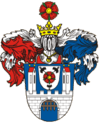 Coat of arms | |
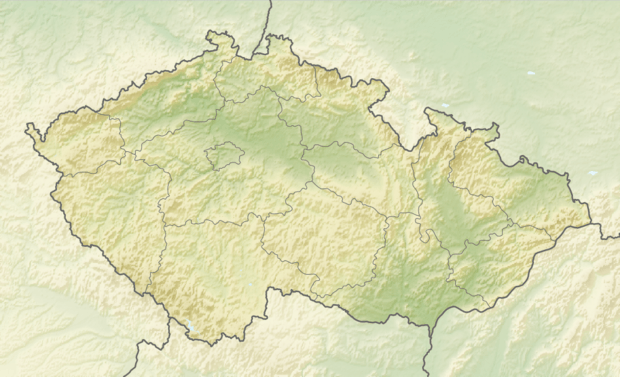 Český Krumlov Location in the Czech Republic | |
| Coordinates: 48°48′40″N 14°18′55″E | |
| Country | Czech Republic |
| Region | South Bohemian |
| District | Český Krumlov |
| First mentioned | 1253 |
| Government | |
| • Mayor | Dalibor Carda |
| Area | |
| • Total | 22.16 km2 (8.56 sq mi) |
| Elevation | 492 m (1,614 ft) |
| Population (2019-01-01[1]) | |
| • Total | 13,085 |
| • Density | 590/km2 (1,500/sq mi) |
| Time zone | UTC+1 (CET) |
| • Summer (DST) | UTC+2 (CEST) |
| Postal code | 381 01 |
| Website | www.ckrumlov.info |
| Official name | Historic Centre of Český Krumlov |
| Criteria | iv |
| Reference | 617 |
| Inscription | 1992 (16th session) |
The town's name begins with Český ("Bohemian") to differentiate it from Moravský Krumlov in south Moravia.
History
The settlement arose beneath the castle, which was built from about 1240 onwards by a local branch of the noble Vítkovci family, descendants of Witiko of Prčice. The fortress was first mentioned in a 1253 deed as Chrumbenowe. According to local legend, the name derives from Middle High German krumbe ouwe which can be translated as "crooked meadow", after a bend of the Vltava River. It was also mentioned in the 1255 Frauendienst poem by minnesinger Ulrich von Liechtenstein. Located at a ford of an important trade route in the Kingdom of Bohemia, a settlement arose soon afterwards below the castle. The Czech name Krumlov is documented as early as in 1259.
In 1302 the Vítkovci line became extinct and King Wenceslaus II ceded the town and castle to the Rosenberg family (Rožmberkové). Peter I of Rosenberg (d. 1347), the Lord Chamberlain of King John of Bohemia, resided here and had the present upper castle erected in the early 14th century. The majority of inhabitants were German-speaking at that time, having migrated from neighbouring Austria and Bavaria in the course of the Ostsiedlung. A Jewish community is documented since 1334. By 1336, Czechs may have formed a small minority, which had its own priest.[3]
The Rosenbergs strongly promoted trade and crafts within the town walls. In the late 15th century, when gold was found next to the town, German miners came to settle, which shifted the ethnic balance even more. In one of the churches the sermons were preached in Czech until 1788, when St. Jošt Church was closed.[4] William of Rosenberg (1535–1592), High Treasurer and High Burgrave of Bohemia, had the castle rebuilt in a Renaissance style.
In 1602 William's brother Peter Vok of Rosenberg (1539–1611) sold Krumlov to the Habsburg emperor Rudolf II, who gave it to his natural son Julius d'Austria. After the Bohemian Revolt and the 1620 Battle of White Mountain, Emperor Ferdinand II gave Krumlov to the noble House of Eggenberg and the town became seat of the mediate Duchy of Krumlov. From 1719 until 1947 the castle belonged to the House of Schwarzenberg.
There were 8,662 inhabitants in Krummau an der Moldau in 1910, including 7,367 Germans and 1,295 Czechs. After the First World War, the city was part of the Bohemian Forest Region which was initially declared to be part of German-Austria. By the end of 1918 the Czechoslovak army had occupied the region, which became part of Czechoslovakia. In 1938 it was annexed by Nazi Germany, as part of the Reichsgau Oberdonau unit of Sudetenland under the Munich agreement. After World War II the town's long-standing German-speaking population was expelled and the town was returned to Czechoslovakia.[5]
During the Communist era of Czechoslovakia, historic Krumlov fell into disrepair, but since the Velvet Revolution of 1989 much of the town's former beauty has been restored, and it is now a popular holiday destination, with large numbers of tourists from Europe and from Asian countries such as China and Japan. In August 2002, the town was damaged in a great flood of the Vltava River.
Sights
Most of the architecture of the old town and castle dates from the 14th through 17th centuries; the town's structures are mostly in Gothic, Renaissance, and Baroque styles. The core of the old town is within a horseshoe bend of the river, with the old Latrán neighborhood and castle on the other side of the Vltava.
Castle

Český Krumlov Castle is unusually large for a town of its size; within the Czech Republic it is second in extent only to the Hradčany castle complex of Prague. Inside its grounds are a large rococo garden, an extensive bridge over a deep gap in the rock upon which the castle is built, and the castle itself, which in turn consists of many defined parts dating from different periods. After the garden had been inadequately maintained in the second half of the 20th century, the site was included in the 1996 World Monuments Watch by the World Monuments Fund. With financial support from American Express the garden's central fountain was documented and reconstructed, and remains functional today.[6]
It is relatively unique in that it is surrounded by a moat filled not with water, but with bears.[7] This was an attempt the erstwhile rulers of the castle to associate themselves with the powerful Orsini family - whose name is a pun on the Italian word for bear; orso.[8]
Castle Theatre
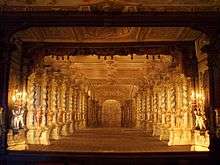
Český Krumlov Castle preserves its Baroque theatre, built in 1680–82 under Prince Johann Christian I von Eggenberg and renovated with up-to-date stage equipment under Josef Adam zu Schwarzenberg from 1765–66. It is one of few such court theaters to retain its original stage machinery, scenery and props.[9] Due to its age, the theater is only used three times a year (only twice open to the public), when a Baroque opera is performed in simulated candlelight. Visitors can take a guided tour beneath the stage to catch a glimpse of the wood-and-rope apparatus that allowed stage settings to be moved in and out at the same time as the audience was diverted with fireworks and smoke. The castle's last private owner was Adolph Schwarzenberg. It was here that he received President Edvard Beneš and gave him a large contribution for the defence of Czechoslovakia against the growing threat of Nazi Germany. His property was seized by the Gestapo in 1940 and then confiscated by the Czechoslovak government in 1947.
Since 1959 the revolving auditorium is located in the gardens.
Nearby
Český Krumlov has a museum dedicated to the painter Egon Schiele, who lived in the town.
About 10 kilometres (6 miles) from Krumlov is one of Bohemia's oldest monasteries, Zlatá Koruna ("The Golden Crown"). About 30 km (19 mi) from Krumlov is the Hluboka Castle, established in the twelfth century and later remodelled in imitation of Windsor Castle.
Český Krumlov is close to the Šumava National Park, the Czech Republic's largest national park. The Šumava mountains lie along the border with Austria and Germany and offer a range of natural habitats – peat bogs, Alpine meadows, old-growth forest, lakes, and rivers. The area is popular with walkers, cyclists, and canoeists on the Vltava. Cesky Krumlov is a short distance from the man-made Lake Lipno, on which many people take boat trips to various small towns and to the dam, with its Hydro power plant.

Český Krumlov is home to the Pivovar Eggenberg brewery. It has been used for locations in movies such as The Illusionist (2006) and Hostel (2005), as well as the 1973 German movie Traumstadt (Dream City).[10]
Culture
Český Krumlov hosts a number of festivals and other events each year including the Five-Petaled Rose Festival (a reference to the rose of the Rožmberk crest), which is held on the summer solstice weekend. The downtown area is turned into a medieval town with craftsmen, artists, musicians, and local people in medieval costume. Activities include jousting, fencing, historical dance performances, and folk theater, in the Castle precincts and along the river. It concludes with a fireworks display.
The International Music Festival Český Krumlov begins in July and ends in August, and features international music of various genres.[11] Other such events are held throughout the year. The summer music festivals include the blues, rock, and soul festival Open Air Krumlov, held in late June at Eggenberg Brewery Garden.
Since the Velvet Revolution in 1989, over eighty restaurants have been established in the area. Many restaurants are located along the river and near the castle.
There is a museum dedicated to the semi-precious gemstone Moldavite in the city center.[12]
Transport
Český Krumlov has a railway station served by GW Train Regio and České dráhy situated on a line between České Budějovice and Černý Kříž (a railway junction near the village of Stožec). There has been a direct train to Prague since 2016, with a traveling time of 2h 48m.[13][14] Several bus companies operate direct bus services to Prague. There are also direct shuttle minibus services to several cities including Prague, Munich and Vienna.
International relations
Twin towns — sister citiesČeský Krumlov is twinned with:[15]
|
Friendly towns and citiesČeský Krumlov has friendly relationship with:[15]
|
Notable people
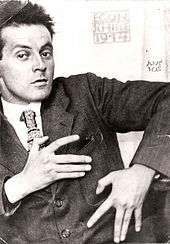
- House of Rosenberg (Czech: Rožmberk(ové), sg. z Rožmberka), since about 1250
- House of Eggenberg (since 1622 until 1717)
- Anton Hickel (1745–1798), painter
- Egon Schiele (1890–1918), painter, lived here; there is a museum devoted to him in the town, the Egon Schiele Art Centrum. He painted townscapes such a Dämmernde Stadt (1913).
- Karel Šmirous (1890–1981), scientist
- Petr Eben (1929–2007), composer
- Anna Chromý (born 1940), painter and sculptor
- Dana Kuchtová (born 1961), politician
- Luděk Sekyra (born 1964), businessman
- Petr Muk (1965–2010), pop singer
- Tomáš Kobes (born 1978), slalom canoeist
- Jan Matura (born 1980), ski jumper
References
- "Population of municipalities of the Czech republic". Czech Statistical Office. Retrieved 2019-04-30.
- "Historic Centre of Český Krumlov". Retrieved 15 July 2013.
- Walter Kuhn, Geschichte der deutschen Ostsiedlung in der Neuzeit, Vol. 1 (Cologne 1955), p. 85.
- Ecclesiastical History of Český Krumlov
- History of the town of Český Krumlov
- World Monuments Fund – Český Krumlov Garden
- "Bear Moat at Český Krumlov Castle". www.castle.ckrumlov.cz. Retrieved 2019-07-28.
- Winder, Simon (2013). Danubia: A personal history of Habsburg Europe. London, UK: Picador. p. 115. ISBN 978-1-4472-2977-3.
- There are others at Drottningholm and Gripsholm in Sweden. Much Baroque theater equipment is on display at the Royal Palace of Gödöllő, near Budapest.
- IMDb Retrieved 28 March 2017.
- "Krumlov International Music Festival". Retrieved 28 July 2014.
- "Moldavite Museum". Retrieved 28 July 2014.
- "Budějovice a jižní Čechy - zprávy". iDNES.cz. Retrieved 18 April 2017.
- "České dráhy, a.s." old.cd.cz. Retrieved 18 April 2017.
- "Partnerská a spřátelená města Českého Krumlova" (in Czech). Český Krumlov. 2019-01-08. Retrieved 2019-08-15.
External links
| Wikimedia Commons has media related to Český Krumlov. |
| Wikivoyage has a travel guide for Český Krumlov. |
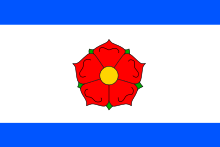
panoramic.jpg)